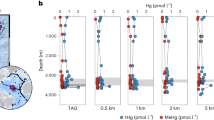Abstract
IN a letter in NATURE of Mar. 16, Mr. N. K. Adam describes the floating of small globules of mercury on a water surface, even when the latter was considerably contaminated. He concludes that for equilibrium to be possible, the mercury-air tension must have been reduced by the order of one or two hundred dynes. It is not necessary to suppose such a decrease. It appears that the part played by curvature of the surfaces in determining conditions for the equilibrium or the spreading of one liquid on another has been neglected. Experimentally, we have the observations of Burdon (Proc. Roy. Soc., 38, 2, 154; 1926), who found that water would spread over the surface of a large, clean mercury drop, but that its progress was stopped when the curved edge of the drop was reached, where acceleration ‘downhill’ would be expected.
This is a preview of subscription content, access via your institution
Access options
Subscribe to this journal
Receive 51 print issues and online access
$199.00 per year
only $3.90 per issue
Buy this article
- Purchase on SpringerLink
- Instant access to full article PDF
Prices may be subject to local taxes which are calculated during checkout
Similar content being viewed by others
Author information
Authors and Affiliations
Rights and permissions
About this article
Cite this article
BURTON, C. Floating Mercury on Water. Nature 123, 759 (1929). https://doi.org/10.1038/123759a0
Issue date:
DOI: https://doi.org/10.1038/123759a0



